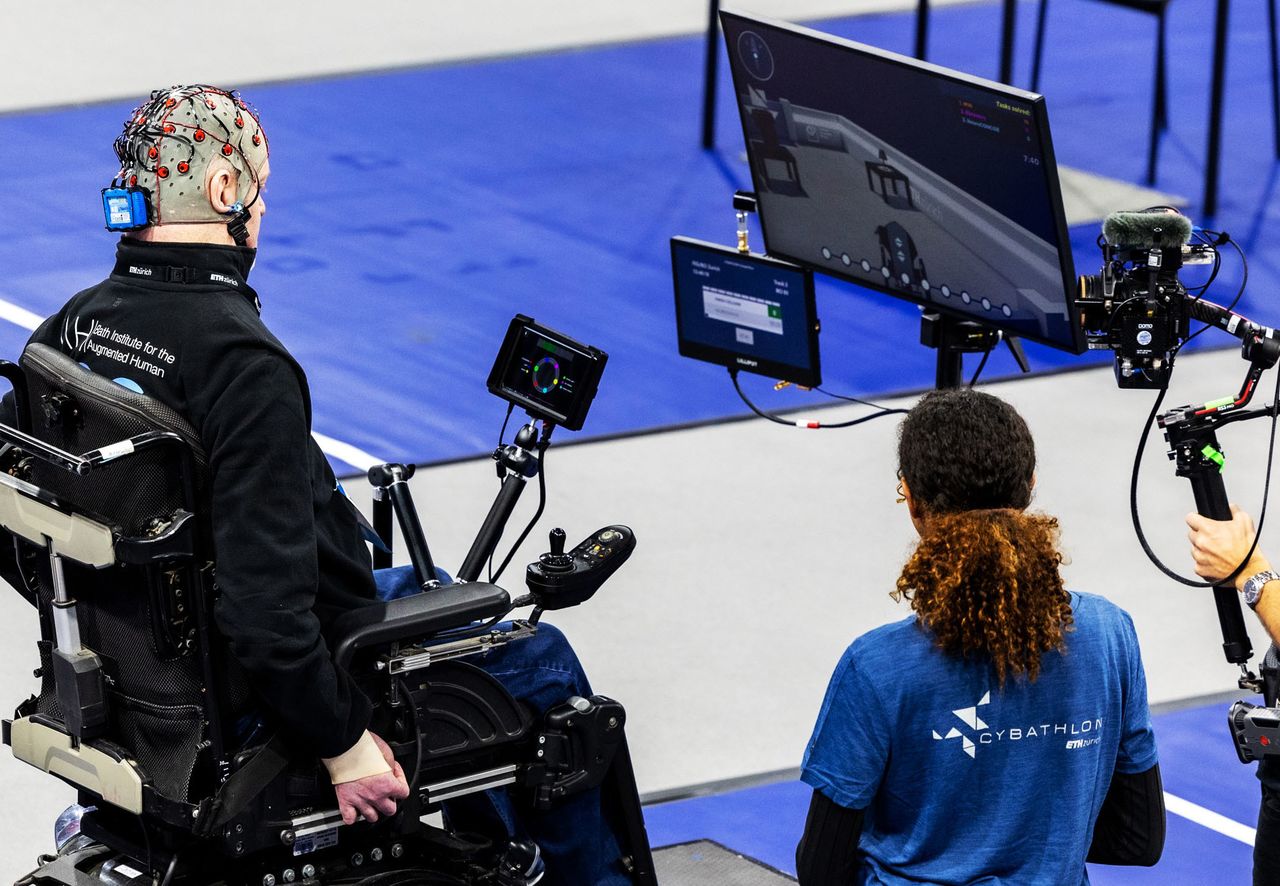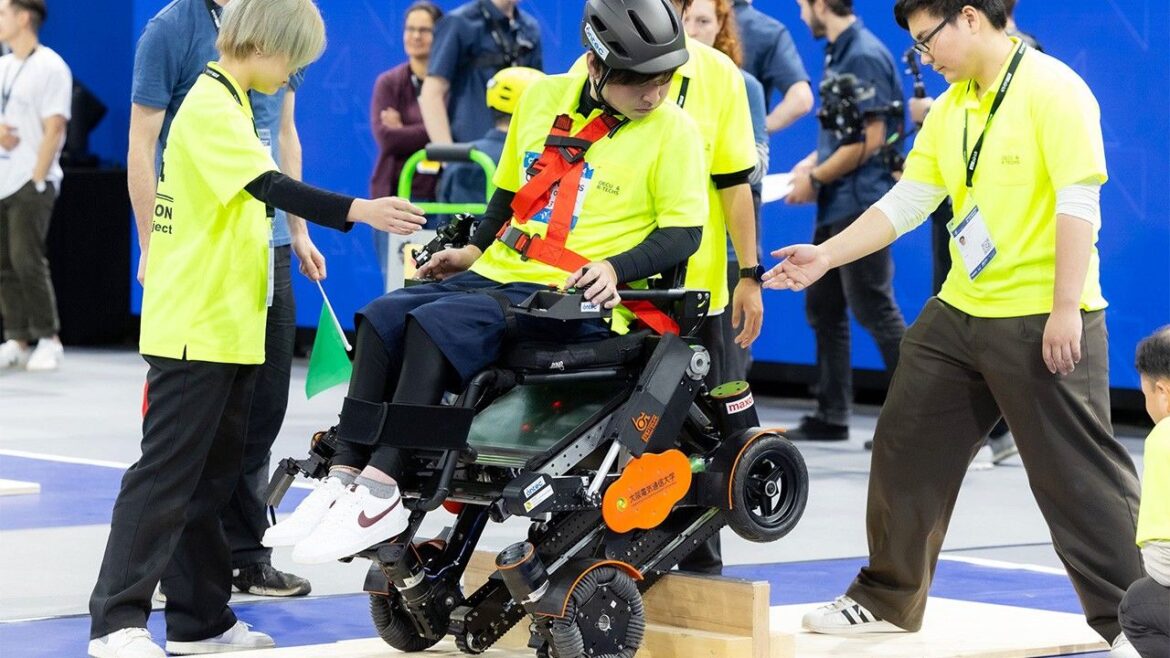The third Cybathlon took place in late 2024, bringing together technology-development teams from around the world in competitions featuring their devices to assist people with disabilities. A look at some of the promising tech on display and a Japanese team’s success in the wheelchair competition.
Competing Through Robotics
Cybathlon is an engineering- and robotics-focused competition held by the Swiss university ETH Zürich every four years since 2016. Its name is a coinage combining the mechanical engineering term cyber with the competitive suffix –athlon. People with disabilities compete as pilots for assistive equipment incorporating robotics technology to earn points by performing specific tasks.
The Paralympics, which began as a rehabilitation scheme for people with disabilities, involve competition based on individual skill and ability that can rely on assistance technology. In Cybathlon, though, the focus is placed on promoting cutting edge technological development. Both competitions seek to improve the quality of life for people with disabilities, but their approaches differ.

A crowd of 7,000 spectators packed the Swiss Arena for Cybathlon 2024. (© Ochi Takao)
The third competition ran for three days from October 25 to 27, 2024. A total of 67 teams from 24 countries joined to compete in eight different disciplines, including Arm Prosthesis, Brain Computer Interface, Vision Assistance, and Powered Wheelchair races. It was a lively event, with 7,000 people watching in person and 21,000 watching online.
Praise for Usability
Japan has sent teams since the first event, and this time the second appearance by a group from the Osaka Electro-Communication University drew attention. The team joined the wheelchair race, which included 10 tasks such as traversing stairs. The team was selected for the Jury Award, a special prize recognizing the innovation, usability, and generalization.

The Osaka Electro-Communication University powered wheelchair incorporates height adjustment technology. (© Ochi Takao)
The key reason for its award was compactness. The first prize winner, a chair from the British Columbia Institute of Technology, was a massive machine that could easily handle every task, while the OECU team gave consideration to practicality with a chair that could pass through home doorways. Its chair was less than half the size of the BCIT team’s, and roughly the same size as, or smaller than, commercially available chairs.
The tires included belt-based crawler designs that improved its navigation of stairs. All four tires also had independent drives to increase running power, and the front tires incorporated omniwheel technology to allow better directional control. This advanced functionality helped the chair complete four vital tasks.
The chair also stood out for its use of scissor-lift design for height adjustment, which can help users perform daily activities that require different working heights, like desk work or cooking. The seat also has an automatic tilt mechanism which engages on downward slopes, reducing worry for users unable to brace themselves due to leg mobility issues.

The British Columbia Institute of Technology powered wheelchair took first place. Its hefty size stood out from the crowd. (© Ochi Takao)
Listening to the Pilot
Development was guided by Korean-born professor Jeong Seonghee and students in his lab. They listened to and discussed feedback from their pilot in achieving a crystallization of advanced technology.

OECU team leader Professor Jeong. (© Ochi Takao)
The concept was proposed by paraplegic Ogura Toshinori, who also piloted the chair. “Large wheelchairs are unusable in Japan’s narrow living environments. We prioritized a compact, easy to use wheelchair with an eye on future commercialization. I was so happy about getting the Jury Award,” he commented.
Ogura has been a wheelchair user ever since a workplace accident 17 years ago. A longtime vehicle lover, he was left unable to enjoy his former motorcycle hobby. However, after struggling with that disappointment, he was able to comfort himself and be more positive about his new life in a wheelchair with a single idea: “Hey, you’re in a vehicle all the time now!”
His new role model was Aaron Fotheringham, an American wheelchair athlete who has achieved skateboard-inspired backflips and 20-meter jumps in his own chair. He showed off an acrobatic aerial performance at the 2016 Rio Olympics. The sight of that unimaginable skill encouraged Ogura to go higher himself.
Ogura says, “I thought about how great traversing stairs would be for daily life. I also wanted to be involved in vehicle development. I wanted to offer whatever help I could to the students making this powered wheelchair.”

The OECU team members at the award ceremony. (© Ochi Takao)
Addressing Concerns in a Growth Industry
Professor Jeong explained that the value of Cybathlon extended far beyond the competition results. Students get an opportunity to talk with people with disabilities to better refine functionality and create a tool to help solve their daily concerns. It helps nurture their skills as engineers.
Team member Yumisashi Sae, a senior at OECU, says of the development process, “I learned the importance of listening to Ogura as someone with a disability and implementing his knowledge in our planning.”
The technology used in Cybathlon is commonly known as “human augmentation technology,” which expands the abilities of humans. The American research firm Fortune Business Insights says that the global HAT market reached a scale of $169 billion in 2023. It projects growth to nearly $886 billion by 2032, making it a market worth watching.
The Japanese government, concerned about the trend of an aging society, in 2012 proposed the use of robotics technology in nursing care as an essential field. Technological development has been proceeding ever since. As of 2022, the domestic market for nursing care robots planned by private companies, including tools for transfer, transport, cleaning and bathing, and observation, was ¥2.2 billion, and is expected to reach ¥3.6 billion in 2025.
Wakayama University Professor Nakajima Shūrō, who led a team in the vision assistance discipline, says, “Lots of people in Japan think of robots as some kind of high-tech objects, but they’re going to become parts of basic infrastructure, just like railroads and expressways. The Cybathlon is a venue for spectators to experience how technology development is going to look in the future.” He goes on to explain that while Japan’s technical capabilities are on par with other strong participant nations like Switzerland or China, it faces obstacles of inadequate staff at university labs, scarcity of funding, and the requirements around disabled pilot safety.

Cybathlon cofounder Robert Riener watching the competition. (© Ochi Takao)
Brain Implants Make an Appearance
One discipline drawing attention at this latest competition was the BCI race. The competition uses special headgear to read competitor brainwaves to control a digital avatar in a wheelchair to navigate obstacles.
The winning team was PittCrew, from the Rehab Neural Engineering Labs of the University of Pittsburgh. Their entry used chips implanted directly in the brain of their pilot, a man paralyzed from the neck down. This brain implant technology is still in development, but it offers a huge boost in information transfer over the headgear systems. Their victory was overwhelming, with twice the points of the second place entry.

The BCI competition uses headgear to read brainwave signals. This, the third competition, was won by an American team using chips directly implanted in the pilot’s brain. (© Ochi Takao)
This technology has progressed to the point where it can read what a person is thinking and display it as text on a monitor. There is still no evidence as to what impact this science-fictional technology will have on the human body, but some are already pointing out ethical issues. However, there is also expectation that it will grow into big business in the near future. In the United States, Tesla CEO Elon Musk and Mark Zuckerberg, CEO of Facebook parent company Meta, are major investors in the tech.
ETH Zürich Professor Robert Riener, who planned and proposed the Cybathlon, has this to say: “The Paralympics seeks out athletes with outstanding athletic ability, which excludes people with severe disabilities. In the Cybathlon, we are showcasing people with severe disabilities, competing using powered equipment. People with disabilities struggle with a number of issues in their daily lives, and we have about twenty ideas for new competition disciplines.”
It seems that the Cybathlon’s scope is set to keep growing.
(Originally published in Japanese. Banner photo: The powered wheelchair entered into Cybathlon by the OECU and R-Techs team. Ogura Toshinori is piloting the chair. © Ochi Takao.)


AloJapan.com